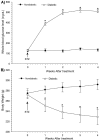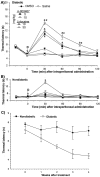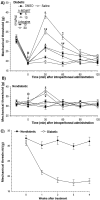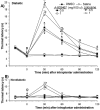Antinociceptive activities of lidocaine and the nav1.8 blocker a803467 in diabetic rats
- PMID: 23312086
- PMCID: PMC3447446
Antinociceptive activities of lidocaine and the nav1.8 blocker a803467 in diabetic rats
Abstract
The streptozocin-induced diabetic rat is a model of chronic pain that shows signs of hyperalgesia and allodynia and may replicate signs in diabetic humans. Here we investigated the antinociceptive effects of A803467, a highly selective blocker of Nav1.8 channels, in diabetic rats with painful neuropathy. We systemically (intraperitoneal) or locally (intraplantar) administered A803467 (or lidocaine, a nonselective sodium channel blocker, as a control) to diabetic rats with hyperalgesia and allodynia and then measured thermal latencies and mechanical thresholds. With intraperitoneal administration, A803467 led to 6-fold greater reduction of hyperalgesia and 2-fold greater reduction of allodynia than did lidocaine. Whereas the antihyperalgesic effects of lidocaine and A803467 were similar after intraplantar administration, A803467 (1 mg) was at least 2 times more effective as an antiallodynic than was lidocaine (0.5 mg). These results suggest that compared with lidocaine, systemic or local blockade of Nav1.8 channels by A803467 may more effectively relieve hyperalgesia and allodynia in diabetic neuropathy.
Figures





Similar articles
-
Methylglyoxal mediates streptozotocin-induced diabetic neuropathic pain via activation of the peripheral TRPA1 and Nav1.8 channels.Metabolism. 2016 Apr;65(4):463-74. doi: 10.1016/j.metabol.2015.12.002. Epub 2015 Dec 17. Metabolism. 2016. PMID: 26975538
-
Comparison of actions of systemically and locally administrated local anaesthetics in diabetic rats with painful neuropathy.Fundam Clin Pharmacol. 2013 Apr;27(2):161-8. doi: 10.1111/j.1472-8206.2011.00998.x. Epub 2011 Oct 11. Fundam Clin Pharmacol. 2013. PMID: 21985706
-
Osteoarthritis-dependent changes in antinociceptive action of Nav1.7 and Nav1.8 sodium channel blockers: An in vivo electrophysiological study in the rat.Neuroscience. 2015 Jun 4;295:103-16. doi: 10.1016/j.neuroscience.2015.03.042. Epub 2015 Mar 25. Neuroscience. 2015. PMID: 25818052 Free PMC article.
-
Functional upregulation of nav1.8 sodium channels on the membrane of dorsal root Ganglia neurons contributes to the development of cancer-induced bone pain.PLoS One. 2014 Dec 11;9(12):e114623. doi: 10.1371/journal.pone.0114623. eCollection 2014. PLoS One. 2014. PMID: 25503076 Free PMC article.
-
The role of sodium channels in painful diabetic and idiopathic neuropathy.Curr Diab Rep. 2014 Oct;14(10):538. doi: 10.1007/s11892-014-0538-5. Curr Diab Rep. 2014. PMID: 25142720 Review.
Cited by
-
A novel definition and treatment of hyperinflammation in COVID-19 based on purinergic signalling.Purinergic Signal. 2022 Mar;18(1):13-59. doi: 10.1007/s11302-021-09814-6. Epub 2021 Nov 10. Purinergic Signal. 2022. PMID: 34757513 Free PMC article. Review.
-
A Phase 1, Randomized, Double-Blind, Placebo-Controlled, Crossover Study to Evaluate the Pharmacodynamic Effects of VX-150, a Highly Selective NaV1.8 Inhibitor, in Healthy Male Adults.Pain Med. 2021 Aug 6;22(8):1814-1826. doi: 10.1093/pm/pnab032. Pain Med. 2021. PMID: 33543763 Free PMC article. Clinical Trial.
-
The Novel Activity of Carbamazepine as an Activation Modulator Extends from NaV1.7 Mutations to the NaV1.8-S242T Mutant Channel from a Patient with Painful Diabetic Neuropathy.Mol Pharmacol. 2018 Nov;94(5):1256-1269. doi: 10.1124/mol.118.113076. Epub 2018 Aug 22. Mol Pharmacol. 2018. PMID: 30135145 Free PMC article.
-
Pain transduction: a pharmacologic perspective.Expert Rev Clin Pharmacol. 2016 Aug;9(8):1069-80. doi: 10.1080/17512433.2016.1183481. Epub 2016 May 23. Expert Rev Clin Pharmacol. 2016. PMID: 27137678 Free PMC article. Review.
-
Status of peripheral sodium channel blockers for non-addictive pain treatment.Nat Rev Neurol. 2020 Dec;16(12):689-705. doi: 10.1038/s41582-020-00415-2. Epub 2020 Oct 27. Nat Rev Neurol. 2020. PMID: 33110213 Review.
References
-
- Akopian AN, Souslova V, England S, Okuse K, Ogata N, Ure J, Smith A, Kerr BJ, McMahon SB, Boyce S, Hill R, Stanfa LC, Dickenson AH, Wood JN. 1999. The tetrodotoxin-resistant sodium channel SNS has a specialized function in pain pathways. Nat Neurosci 2:541–548 - PubMed
-
- Amaya F, Decosterd I, Samad TA, Plumpton C, Tate S, Mannion RJ, Costigan M, Woolf CJ. 2000. Diversity of expression of the sensory-neuron-specific TTX-resistant voltage-gated sodium-ion channels SNS and SNS2. Mol Cell Neurosci 15:331–342 - PubMed
-
- Andriambeloson E, Baillet C, Vitte PA, Garotta G, Dreano M, Callizot N. 2006. Interleukin-6 attenuates the development of experimental diabetes-related neuropathy. Neuropathology 26:32–42 - PubMed
-
- Bean BP. 2007. The action potential in mammalian central neurons. Nat Rev Neurosci 8:451–465 - PubMed
-
- Berkley KJ. 1997. Sex differences in pain. Behav Brain Sci 20:371–380 - PubMed
Publication types
MeSH terms
Substances
LinkOut - more resources
Full Text Sources
Other Literature Sources
Medical
